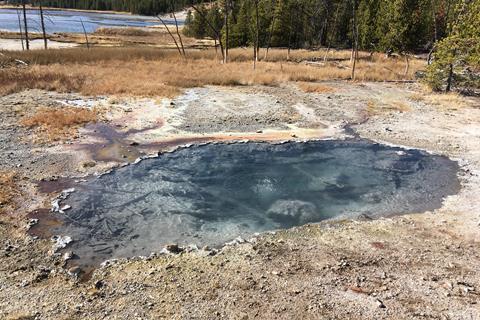A new study has uncovered a relationship between nutrient availability and diversity in microbial communities living in Yellowstone hot springs.
The paper by researchers at Montana State University, ‘Relationships between fluid mixing, biodiversity, and chemosynthetic primary productivity in Yellowstone hot springs’ has been published in Environmental Microbiology, an Applied Microbiology International publication.

Fourth year doctoral student Maria C Fernandes-Martins, who carried out the field and laboratory work, says that from a macro-biological perspective, a greater variety and abundance of food in an environment has been shown to support more biodiverse communities that themselves are more productive.
“However, such studies tend to focus on communities that are supported by solar radiation (photosynthesis) which is in abundant supply. Whether such a relationship extends to chemosynthetic microbial communities is not known,” she says.
“This is a major knowledge gap since such communities occupy Earth’s vast subsurface, constitute a significant proportion of Earth’s biomass, and contribute to global biogeochemical cycles.
“In chemosynthetic metabolism, reduced and oxidized chemical species (electron donor and acceptors) that are in disequilibrium are reacted (in pairs) to release energy that can be used to power biomass synthesis. Therefore, it follows that processes that maintain disequilibrium in chemosynthetic ecosystems should, at first order, control the biodiversity of those communities and their productivity.”
Chemosynthetic ecosystems
Ms Fernandes-Martins says their study identifies a relationship between processes that increase the availability of nutrients for chemosynthetic microbial communities, the taxonomic and functional biodiversity of those communities, and their primary productivity.
Chemosynthetic ecosystems are common in environments where light is excluded, such as in the subsurface, beneath ice sheets, but can also be found on the surface of Earth where geochemical conditions exclude photosynthetic organisms.
“One example of a near surface environment that excludes photosynthetic organisms are high temperature hot springs. We investigated three co-localized Yellowstone hot springs and characterized their geochemistry to identify differences in the processes that source fluids to those springs,” she says.
“We found differences in each of the fluid mixing regimes sourcing the hot springs and showed that this controlled the availability of nutrients in these waters. In particular, a spring sourced with reduced waters and oxidized meteoric waters that are infused by volcanic gases had increased variation in available nutrients.
“We extracted genomic DNA from the communities and subjected it to metagenomics sequencing and analysis. We found that communities that inhabited the spring that have a greater availability of and variation in nutrients hosted more biodiverse communities in all dimensions examined (taxonomic, genomic, functional, and phylogenetic). This was particularly true for autotrophic organisms that represent the primary producers in these communities.
Primary production
“Using microcosm assays, we measured rates of primary production. We found that the communities from springs that were more biodiverse had far higher rates of primary production. This means that the geological processes that influence the availability of and variation in nutrients have played a key role in the generation and maintenance of biodiverse communities and this, in turn, has a significant influence on primary production and geochemical cycles.”
It’s estimated that between 20 and 50% of Earth’s biosphere is supported by chemosynthetic metabolism. For the first 1.0 to 1.5 billion years of Earth history, a time when photosynthesis had not yet evolved, 100% of Earth’s biosphere was supported by chemosynthetic metabolism.
“Our study suggests that the geological processes that influence the availability of and variation in nutrients have played a key role in the generation and maintenance of biodiverse microbial communities and this, in turn, has a significant influence on primary production and geochemical cycles,” Ms Fernandes-Martins says.
“As such, this study helps to shed light on the processes that underpin the biodiverse and productive chemosynthetic communities both today, and in the geologic past. Further, they help narrow the conditions of where we might search for life on other geologically active planets, given that productive communities should also be easier to detect.”
She says future work could build on their findings by exploring a larger array of Yellowstone hot springs and applying this theory to other chemosynthetic communities, such as those inhabiting the microfractures in subsurface rock, sediment pore spaces, or the liquid environment between glaciers/ice sheets and bedrock.
“Further work is also needed to explore additional factors that could limit primary productivity, other than availability of chemical energy, such as the residence time of fluids in a habitat, disturbance events, and climate change,” she says.
The study was designed and overseen by principal investigator and professor, Dr. Eric Boyd. Assistant research professor, Dr. Dan Colman, oversaw the bioinformatics components of the work. Ms. Maria C. Fernandes-Martins, a 4th year doctoral student from Brazil in Dr. Boyd’s geobiology laboratory in the Department of Microbiology and Cell Biology at Montana State University, carried out field and laboratory work and performed bioinformatics characterization of the hot springs’ communities. This study was supported by grants from the National Science Foundation and the Joint Genome Institute given to Dr. Boyd and Dr. Colman.
‘Relationships between fluid mixing, biodiversity, and chemosynthetic primary productivity in Yellowstone hot springs’ is published in Environmental Microbiology.
Topics
- Applied Microbiology International
- biodiversity
- bioinformatics characterization
- chemosynthetic metabolism
- chemosynthetic primary productivity
- Community
- Dan Colman
- Environmental Microbiology
- Eric Boyd
- fluid mixing
- geological processes
- Healthy Land
- Maria C Fernandes-Martins
- Montana State University
- Research News
- USA & Canada
- Yellowstone hot springs







No comments yet